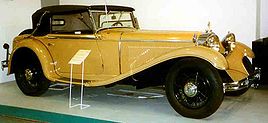- Mercedes-Benz W10
-
Mercedes-Benz W10 
Manufacturer Mercedes-Benz Also called Mercedes Benz Mannheim 350/370 Production 1929 – 1934 Assembly Stuttgart, Germany Predecessor Mercedes-Benz W03 Successor Mercedes-Benz W18 Class Touring car Body style 2/4 door roadster
4 door saloon
4 door limousineLayout FR layout Platform Mercedes-Benz W10 Engine 3444 cc straight 6
3689 cc straight 6
3820 cc straight 8Transmission 3-speed manual Wheelbase 3,200 mm (126.0 in) (350, 370, 380S)
3,030 mm (119.3 in) (370K)
2,850 mm (112.2 in) (370S)Designer Hans Nibel The Mercedes-Benz Mannheim 350 replaced the W03 350 models in 1929. The structure originated by Ferdinand Porsche was modified by Hans Nibel .
Mercedes-Benz Type Mannheim 350 (1929 - 1930)
In contemporary records the car was also sold as the “Mercedes-Benz 14/70 PS”, reflecting respectively its “fiscal” and “actual” horsepower.
In essence the car followed the construction of the its predecessor. However, the wheelbase was reduced by 230 mm (9 inches) and the vehicle even in standard form was a little lighter. In addition to the “Tourer” (two door four seater cabriolet) body, the car was available as a four door saloon and as a “Pullman Limousine”
The straight-six 3444 cc engine was also carried over from the predecessor model. In this application an output of 70 PS (51 kW) was claimed, delivered to the rear wheels through a three speed gear box controlled through a centrally mounted lever. Both axles were rigid, suspended on semi-elliptical leaf springs. Cable-operated brakes provided stopping power to all four wheels. The stated maximum speed was 95 km/h (59 mph).
Mercedes-Benz Type Mannheim 370 (1929 - 1935)
In contemporary records the car was also sold as the “Mercedes-Benz 15/75 PS”
Launched alongside the Mannheim 350 was the Mannheim 370. In this form, the car had a straight-six 3689 cc. Output of 75 PS (55 kW) was claimed. The three speed gear box was offered, at extra cost, with a fourth higher ratio. The maximum speed claimed for the Mannheim 370 was 100 km/h (62 mph)
Mercedes-Benz Type Mannheim 370 K (WK10) (1930 - 1933)
From 1930 the 370K was offered with a wheelbase shortened by 175 mm (7 inches).
Only cabriolet bodied versions of the 370K were offered. The reduced size of the car permitted a maximum speed of 105 km/h (65 mph) to be claimed.
Mercedes-Benz Typ Mannheim 370 S (WS10) (1930 - 1933)
Shorter still, on a wheelbase of just 2850 mm (112 inches) was the 370S, available only with roadster or sport-cabriolet bodies. The maximum speed on these versions was stated as 115 km/h (71 mph). In 1933 the manufacturers increased the compression ratio from 5.5:1 to 5.75:1 with a corresponding increase in power output to 78 PS (57.3 kW) at 3400 rpm
Mercedes-Benz Typ Mannheim 380 S (WS10) (1932 - 1933)
In contemporary records the car was also sold as the “Mercedes-Benz 15/80 PS”
The 380S came on the standard 3,200 mm (126.0 in) wheelbase, but the car was distinguished by its longer eight cylinder side-valve engine. Claimed output of the 3820 cc unit was 80 PS (59 kW).
Available with a choice of cabriolet bodies, the car, like its six cylinder sibling, rode on two rigid axels suspended on semi-elliptical leaf springs. A top speed of 120 km/h (75 mph) was claimed.
Mercedes-Benz Typ 380 S (W19) (1932 - 1933)
In contemporary records the car was also sold as the “Mercedes-Benz 15/85 PS”
A superficially comparable version of the car which appeared towards the end of the product run, the 380S (W19) appeared with swing axle rear suspension and a cross mounted leaf spring arrangement at the front. Reflecting the extent of the change, this model acquired its own internal model number, W19, which differentiates it from the other members of the Mannheim line. This car can really be seen as a prototype for the car’s Type 380 (W22) successor.
A still higher compression ratio accounted for a claimed increase in output to 85 PS (62.5 kW)
Commercial
The cars were too large and expensive ever to sell in large numbers, though the Mannheim 370 broke the 1,000 units barrier. Overall production was as follows:
- W10 350: .........65 cars
- W10 370: ....1,375 cars
- W10 370 S: ....183 cars
- W10 380 S: .......94 cars
- W19 380 S: .......20 cars
Succession
In 1933 the Mercedes Benz Mannheim 350/370s were replaced by the Type 290 (W18) and by the Type 380 (W22)
References
- Oswald, Werner: Mercedes-Benz Personenwagen 1886-1986, Motorbuch-Verlag Stuttgart 1987, ISBN 3613011336
« DMG/Mercedes road car timeline — « Benz road car timeline — Mercedes-Benz road car timeline, 1926–1944 — next »
Class 1920s 1930s 1940s 6 7 8 9 0 1 2 3 4 5 6 7 8 9 0 1 2 3 4 Small car W23 W28 Small family car W15 W136 Family car 10/35 W02 W21 W143 W11 W153 W138 Large family car 16/50 W03 W10 W18 W142 Large car 400 W08 Luxury car 630 W07 W150 W22 W29 / W24 Sports car W06 - This article incorporates information from the equivalent article on the German Wikipedia.
Categories:- Mercedes-Benz vehicles
- Rear wheel drive vehicles
- Roadsters
- 1930s automobiles
Wikimedia Foundation. 2010.
